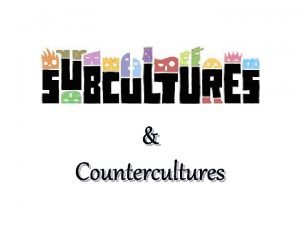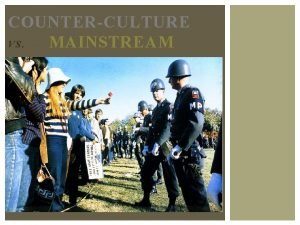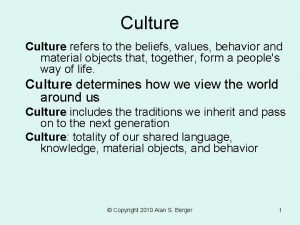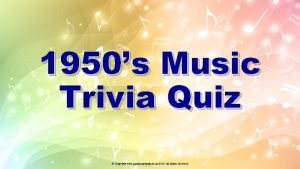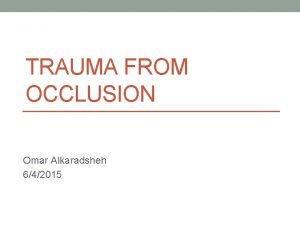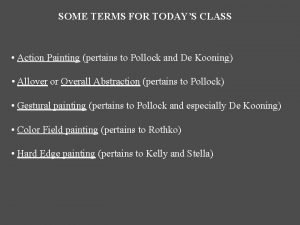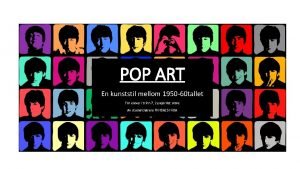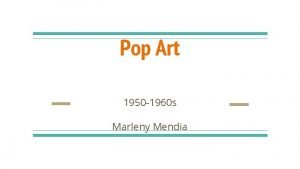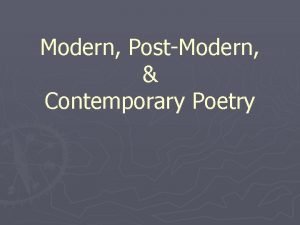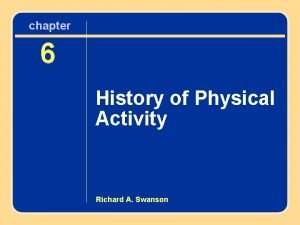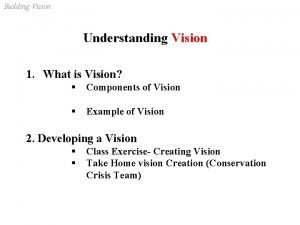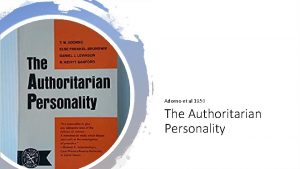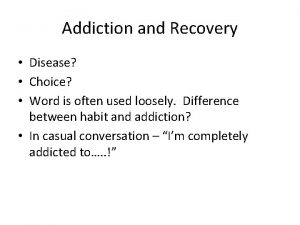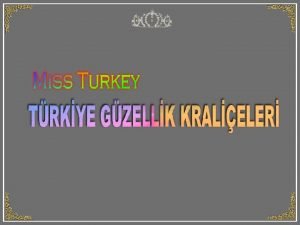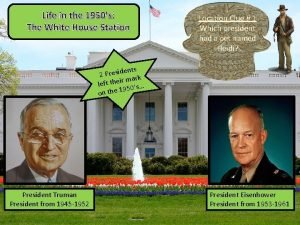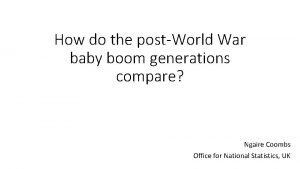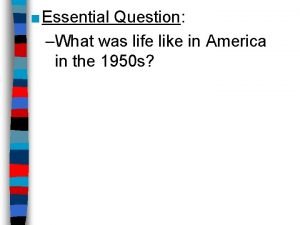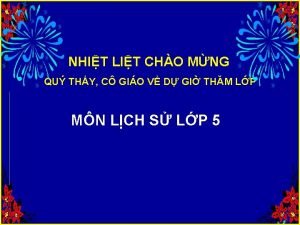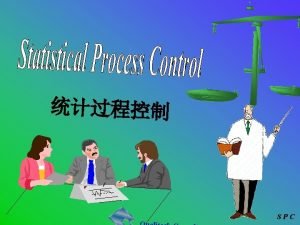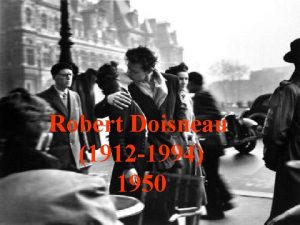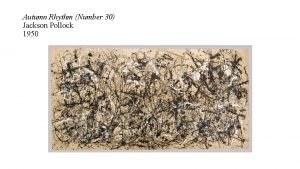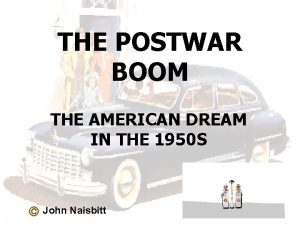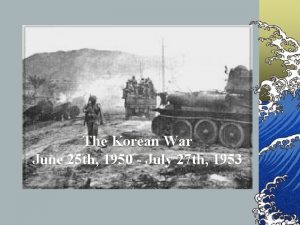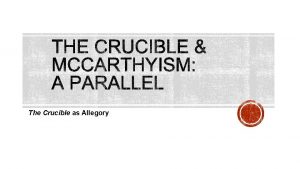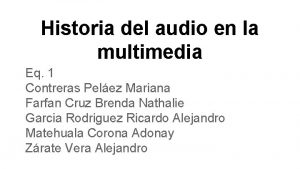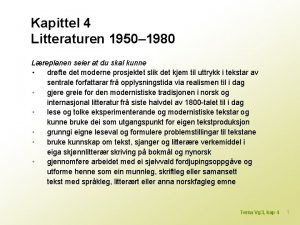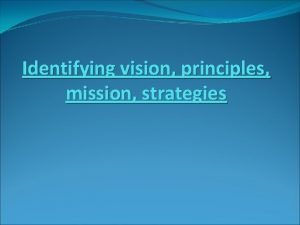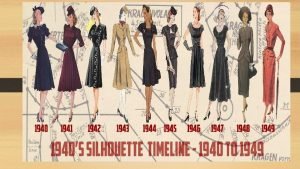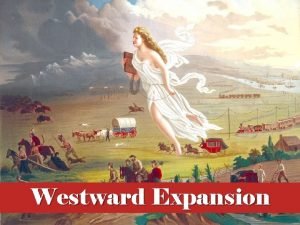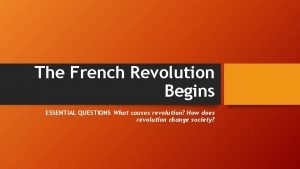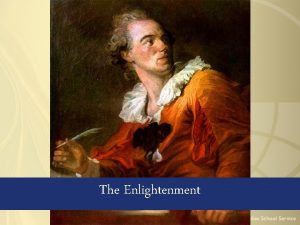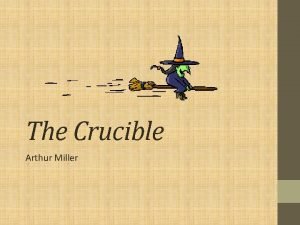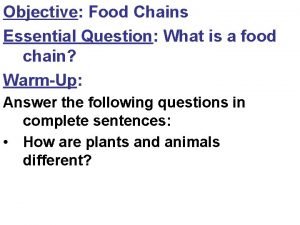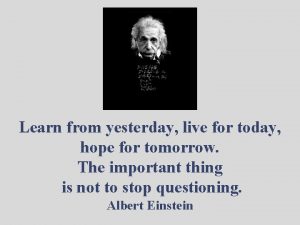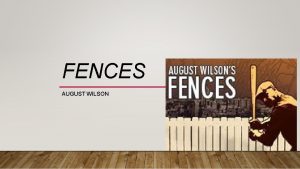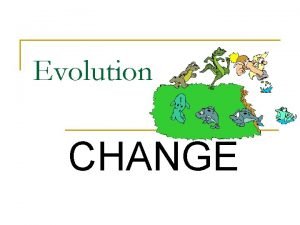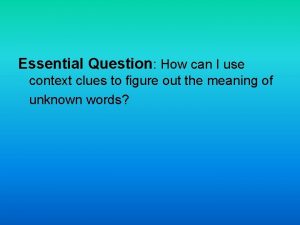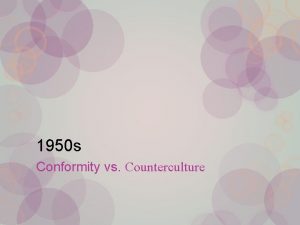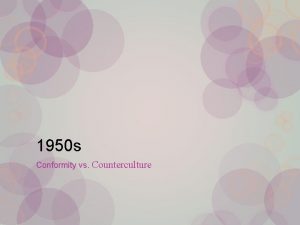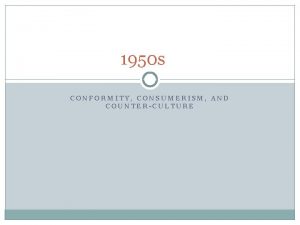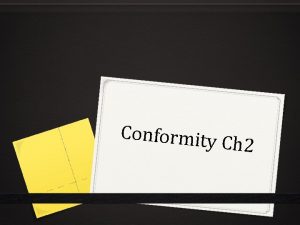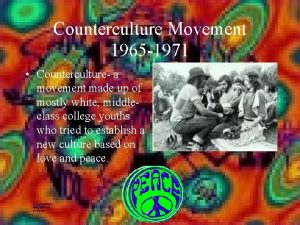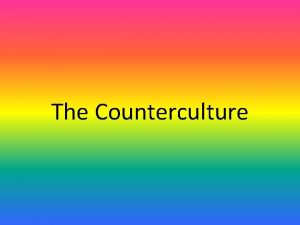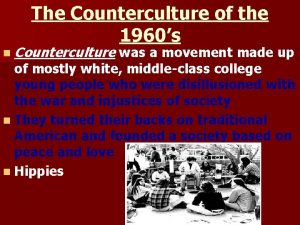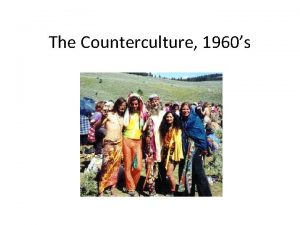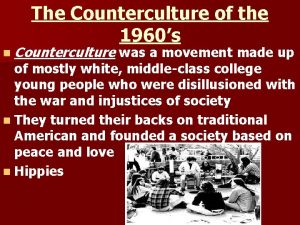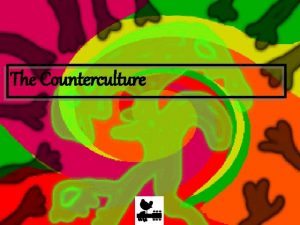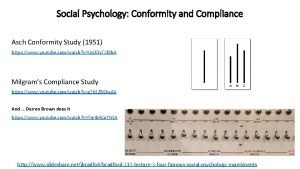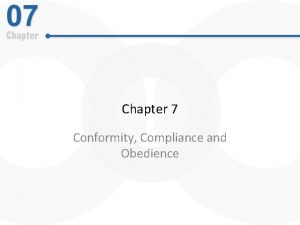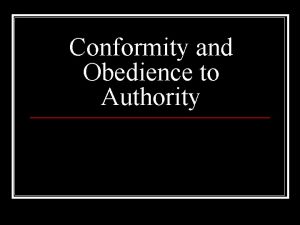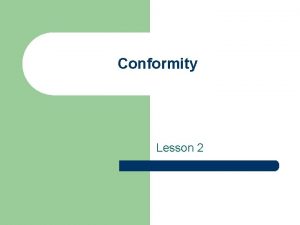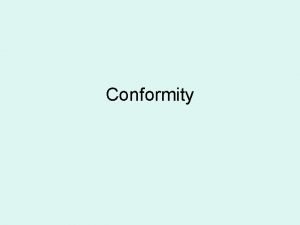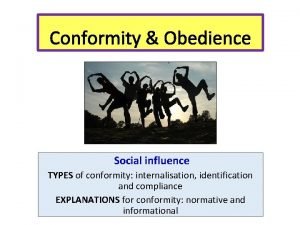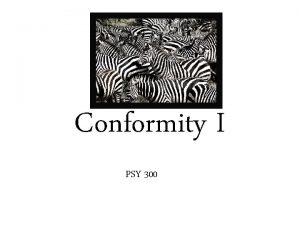1950 s Conformity vs Counterculture Essential Questions To













































































- Slides: 77

1950 s Conformity vs. Counterculture

Essential Questions To what extent was conformity something people wanted, or did they feel obligated to conform? (choice vs. force) Determine the role of gender and age in the 1950 s. Conclude how people used fear to force conformity. Define the ideal 50 s family. What is the real 50 s family?

Pleasantville 1998 American comedy-drama Two American teens in the mid 1990 s are transported back to the world of their favorite sitcom, based in the 1950 s and set in the fictional “Pleasantville” An excellent example of the postmodern genre What is the purpose of this film? What comment is being made on conformity, etc. ?

Pleasantville Reflection Director Gary Ross stated, "This movie is about the fact that personal repression gives rise to larger political oppression. . . That when we're afraid of certain things in ourselves or we're afraid of change, we project those fears on to other things, and a lot of very ugly social situations can develop”. Utopia vs Dystopia

America in the 1950 s NORMALCY Levittown (ie the original Klahanie)

Pleasantville 1. What were the family values of the 1950 s? What were the roles of each of the family members? 2. 3. 4. 5. What was valued most in society during the 1950 s? 6. 7. Why did people resist change in the 1950 s? 8. 9. 10. 11. Conclude what the last scene means. What were some key traits of the ideal 1950 s man/woman? Why does the movie change from black and white to color? David claims the people “are happy like this”. To what extent do you think the people of the 1950 s were really happy? Explain with evidence from the film. When speaking about the town meeting, and Betty’s “condition”, she says she doesn’t want it to go away. Beyond the visual, aspects, what could she be talking about? What is the purpose of this film? What comment is being made on conformity, etc. ? What connections can you make to lit/history we have been covering over the past few weeks?

Pleasantville Reflection What is the purpose of this film? What comment is being made on conformity, etc. ? What connections can you make to lit/history we have been covering over the past few weeks?

The Beats and the Beat Movement 1950 s

“the only people for me are the mad ones, the ones who are mad to live, mad to talk, mad to be saved, desirous of everything at the same time, …[who] burn, burn like fabulous yellow roman candles exploding like spiders across the stars. ” -Jack Kerouac (On the Road) The Beat Generation

The Beats Bohemian The practice of an unconventional lifestyle Celebrated non-conformity and spontaneous creativity Focus on performance, which later inspired ‘Slam Poetry’ Characterized by drug use, sexuality, liberal, bohemian Interested in changing consciousness and defying conventional writing Drew a lot of inspiration from Romanticism and writers such as Thoreau, Emerson, Whitman, Poe, Dickinson

Founders Allen Ginsberg (1926 -1997) Howl, America Mostly Poetry Opposed militarism, materialism and sexual repression Jack Kerouac (1922 -1969) On the Road (1957) Buddhism, Catholic spirituality, jazz, drugs, sexuality and travel Wanted to write ‘the next Great American Novel’ William S. Burroughs (1917 -1997) Naked Lunch (1959) Almost predicted future (AIDS, crack pandemic, liposuction) Semi-autobiographical work Former heroin addict, traveler, convicted of manslaughter (wife in 1951), depression Novels, novellas, short stories, essays Gary Snyder (1930 -) The “Thoreau of the Beats” Rural background & wilderness experience Moved to Japan, Zen Buddhism

Met in New York City, ended up in San Francisco in the mid 1950 s Name was coined by Kerouac, dual meanings of both being “tired” or “beaten down” and “upbeat” “beatific” This was directly in response to a casual conversation about Fitzgerald and the Lost Generation of the American 1920 s Largely middle-class, white, definitely a ‘boys club’ PNW (!!) Kerouac spent a bunch of time in the North Cascades The Dharma Bums On the Road Reed College (Portland, OR)

Scroll of On the Road

Important Places Columbia Greenwich Village San Francisco

Characteristics of the Beat Culture Rejection of received standards Innovations in style Use of illegal drugs Alternative sexualities An interest in examining religions A rejection of materialism Explicit portrayals of the human condition

Beatniks The name suggested that Beats were Far out of the mainstream society Possibly pro-Communist Used as a new stereotype Man with a goatee and a beret reciting nonsensical poetry and playing bongo drums Became satirized and appeared in cartoons, movies, etc. Some original Beats embraced the beatniks stereotypes, though many criticized them as inauthentic poseurs Original hipsters? Later became Hippies

Legacy & Impacts The Obscenity Trials Lawrence Ferlinghetti arrested for distributing Howl in 1957 In the 1960 s elements of the Beat movement were incorporated into the hippie and larger counterculture movements Spiritual liberation Sexual revolution (or liberation) Demystification and/or decriminalization of marijuana Evolution of rhythm and blues into rock and roll as a high art form (Bob Dylan, the Beatles, Janis Joplin, The Grateful Dead, The Rolling Stones, etc. ) Spread of ecological consciousness Opposition to the military-industrial machine civilization

Causalities of the Beats “Kerouac was a casualty too. And there were many other casualties that most people have never heard of, but were genuine casualties. Just as, in the 60 s, when Allen and I for a period there were almost publicly recommending people to take acid. When I look back on that now I realize there were many casualties, responsibilities to bare. ” – Gary Snyder Much of the drug use that the Beats advocated for spiraled from an emphasis on opening creative spaces into a recreational dependence that bordered on (or outright was) dangerous

Allen Ginsberg

I saw the best minds of my generation destroyed by madness, starving hysterical naked, dragging themselves through the negro streets at dawn looking for an angry fix, angelheaded hipsters burning for the ancient heavenly connection to the starry dynamo in the machinery of night. . . —Allen Ginsberg, Howl

Allen Ginsberg (1926 -1997) Leading figure of beats Howl, “America” Styled after epic, free verse of Walt Whitman Work is biographical Mostly poetry

Ginsberg Background Spent a short period of time in a mental institution (Bellevue) after being accused of a crime (pled insanity, not guilt…theft) Father – high school English teacher in New Jersey Mother – loyal Communist, battled mental illness throughout her life, attempted suicides Gay, Jewish, no strongly-declared political affiliation (though definitely left-leaning)

“America” Written 1956, soon after the Mc. Carthy Red Scare Somewhat rambling, stream-of-consciousness Political, and also personal

Learning Targets I can critically read “America” by determining the meaning of historical allusions I can determine how the poem could reflect both 1950 s America and 2020 America I can collaborate to OPCVL the poem

First Step Individually read the poem As a group, examine the underlined terms and create a common theme (10 minutes) As a group, OPCVL the poem (15 minutes) We will OPCVL as a class after

Discussion Questions Does this poem's focus on a past historical period, with all its historical references, make it less relevant to a modern audience? Is the speaker more hopeful about the prospects for America's future? Or more pessimistic? How can you tell? Based on his complaints and desires that we learn about in the poem, what, specifically, do you think the speaker plans on doing when he "[puts his] queer shoulder to the wheel”? To what extent are poets still relevant? Determine their role in change and in society.

Confessional Poets and Women Poets Anne Sexton How and why were the confessional poets a reaction to the male dominated beats?

Learning Targets 1. I can analyze poetry for social commentary 2. I can determine theme of a poem 3. I can contrast beat poets and confessional poets

What is so intriguing and interesting to us about social media? Reality TV? (What is it that draws us in and keeps us wanting more? ? ) Confessional Poetry = the origins of this kind of ‘over-sharing’ in America

Women of the beat generation Beat writings of Kerouac, Ginsberg and Burroughs: Women as boring, traditional gender roles, 50 s American housewife Marginalized, repressed women Women beat writers did exist, but not widely published or known because of the sexism Also harder to live ‘bohemian’ lifestyle as a woman Not really beats, more confessional poets

What is Confessional Poetry? Major figures: Anne Sexton and Sylvia Plath Written during the 1950 s and 1960 s First person narration, traditional writing style remained Intimate autobiographical subject matter Sometimes referred to as grotesque Family life, infidelity, mental disorders, gender roles, sexuality, depression, suicidal tendencies, alcoholism, drug abuse

Anne Sexton Born in Newton, Massachusetts in 1928 Sexton’s childhood was materially comfortable but not happy Rumors of abuse Married Alfred “Kayo” Sexton at age 19 Had two children (1953 and 1955) Suffered from post-partum depression Had breakdown requiring hospitalization after first child Therapist recommended writing as part of her therapy Struggled with depression and bipolar disorder most of her adult life, and committed suicide at age 46 (1974) Celebrated and awarded poet

“She is an important poet not only because of her courage in dealing with previously forbidden subjects, but because she can make the language sing. Of what does [her] artistry consist? Not just of her skill in writing traditional poems… But by artistry, I mean something more subtle than the ability to write formal poems. I mean the artist’s sense of where her inspiration lies… There are many poets of great talent who never take that talent anywhere… They write poems which any number of people might have written. When Anne Sexton is at the top of her form, she writes a poem which no one else could have written. ” –Erica Jong (literary critic)

“Housewife” Group Analysis Explain the poem. Conclude Sexton’s meaning when she says “some women marry houses”. Define “the walls”. Determine the meaning of “A woman is her mother. That’s the main thing”.

“Housewife” Some women marry houses. It's another kind of skin; it has a heart, a mouth, a liver and bowel movements. The walls are permanent and pink. See how she sits on her knees all day, faithfully washing herself down. Men enter by force, drawn back like Jonah into their fleshy mothers. A woman is her mother. That's the main thing.

1950 s Housewife

Learning Targets 1. I can determine the role and value of women in 1950 s society 2. I can use a political cartoon to demonstrate my understanding of the 1950 s housewife

Expectations of a housewife… What stereotypes exist about the 50 s housewife? Determine where these stereotypes come from. To what extent do we still have the same expectations for women today?

What drove culture (& counter -culture) in the 1950 s & 60 s?

How do we go from this…

…to this?



Actual advertisement s from the 1950 s and 60 s…




TV Land While televisions became available in crude form in the 1920 s, they did not become commonplace until the 1950 s This contributed to a rise in this common culture All of a sudden everyone could watch the same shows, access the same images Similar to the radio, but even more powerful Average advertisement was one minute long Whether they realized it or not, the American people were being heavily influenced by what they saw on their TV sets

50 s Television: Perpetuating Conformity The FCC regulated EVERYTHING that appeared on television and radio in the 1950 s. It still regulates all broadcast television. It had very strict rules on what could air, which helped perpetuate the image of perfection and conformity of the American family and society.

Betty Friedan (1921 -2006) Writer, feminist, women’s rights activist Wrote The Feminine Mystique (1963) Co-founded NOW (The National Organization for Women) (1966)

The Feminine Mystique Written in 1963 Sparked 2 nd Wave Feminism 1960 s-1980 s (roughly) Broadened the debate about women’s rights from simply suffrage to include a wider range of issues including reproductive rights, family, workplace, etc. Combined interviews with suburban housewives with research into psychology, advertising, media in order to draw attention to what she saw as “the problem that had no name” Originally intended to publish an article (not a book), but no magazine would publish her

Women and Reproductive Rights Planned Parenthood Margaret Sanger Started in 1916 as The American Birth Control League Operating 222 clinics by 1941 Morphed into Planned Parenthood Federation in 1942 1960 – FDA approved the combined oral contraceptive pill

Sexual Revolution Began in the 1960 s, coincided with the 2 nd wave feminist movement Purpose: to challenge traditional ideas regarding sexuality Particularly regarding female and queer sexuality Eliminating undue favorable bias towards men and objectification of women Associated with both physical and psychological freedom for women Sex was expanding beyond the personal, becoming political as well While a lot of these ideas took their roots from the 1920 s, the 1960 s is when they really began to take off!

Task Today After reviewing the how to guide for being a 50 s housewife, ads, and Tips for Keeping Your Man, your table group will create a political cartoon for the woman’s place in 1950 s society. Must include: role, stereotype, some words, image Written explanations of cartoon on the back

Political Cartoon Definition: illustrations or comic strips containing a political or social message that usually relates to current events or personalities (google. com).

Older Files

Pleasantville 1. What were the family values of the 1950 s? What were the roles of each of the family members? 2. What was valued most in society during the 1950 s? 3. What were some key traits of the ideal 1950 s man/woman? 4. What commentary is the movie making about conformity? 5. Why does the movie change from black and white to color? 6. David claims the people “are happy like this”. To what extent do you think the people of the 1950 s were really happy? Explain with evidence from the film. 7. Why did people resist change in the 1950 s? 8. What does the trial scene remind you of? Why? 9. When speaking about the town meeting, and Betty’s “condition”, she says she doesn’t want it to go away. Beyond the visual, aspects, what could she be talking about? 10. Conclude what the last scene means.

Learning Targets I can critically read “America” by determining the meaning of historical allusions I can determine how the poem could reflect both 1950 s America and 2020 America I can collaborate to modernize the poem to reflect an understanding of the message of “America”

The Beats You will be critically reading “America” (Ginsberg) to determine what exactly beat poetry is. Anything underlined: historical allusion (look them up and write them on the poem as your critical reading assignment

With your group With your table group, collaborate and share the historical allusions you researched for homework (10 minutes) Come up with commonalities (things that are the same): Who are all the people? How would you group the people (politicians, communists, minorities, etc. )? What part of politics does he criticize and why? What parts of society does he criticize and why?

Learning Targets Reminder I can critically read “America” by determining the meaning of historical allusions I can determine how the poem could reflect both 1950 s America and 2018 -19 America I can collaborate to modernize the poem to reflect an understanding of the message of “America”

Beats Refresher Conclude how Ginsberg feels about/describes America. Define the characteristics of beat literature. If the beats were popular today, what social issues do you think they would write about?

“America” With a partner, rewrite the poem with new, more modernly relevant allusions. EX: America when will you send your eggs to India becomes American when will you send your troops to Syria. Pick one line in the poem and analyze for theme Turn in your poem/analysis with both names (turnitin. com) tomorrow before class

Analyzing for Theme First: what is theme of the poem? Pick a line that you think best represents/demonstrates theme Then analyze (explain) how that line supports theme of “America” Theme: overall message or point of something. Will be a sentence, and not just one word EX: hysteria causes loss of control vs. hysteria

Resources For You Use laptops to access the original document, and rewrite that way Use the allusions charts created Friday to remind yourselves about historical allusions and to create modern allusions Reminder: when creating modern poem, remember the purpose of Ginsberg’s original poem. What was he trying to say about 1950 s America? Keep that spirit alive in your modern version.

Confessional Poetry as Postmodern Poetry Postmodern poetry, like its prose counterpart, often dealt with levels of reality, societal contradictions, truth and perception, and critical (not necessarily cynical) analysis of technology and rapid modernization.

Sylvia Plath Born in 1932 in Boston. Parents: father was German immigrant professor, mother was his student. Poet, novelist (most famous for Bell Jar) Her poetry addresses and explores her suffering and mental anguish, her visions of herself, her troubled marriage to poet Ted Hughes, and her strained relationship with her parents (poetryfoundation. com). Suffered from depression and committed suicide (at age 30) “It is as if my life were magically run by two electric currents: joyous positive and despairing negative—whichever is running at the moment dominates my life, floods it. ”-Sylvia Plath

Sylvia Plath (Table Group Analysis) Each table group will be assigned a different Plath poem to analyze 1. For your poem, answer: Determine the message of the poem Conclude theme of the poem Examine her “confession” in the poem 2. Create a discussion question for your poem

Plath and Sexton Reflection 1. To what extent would it be challenging to be a female poet during the 1950 s? 2. How do Plath and Sexton fit with 1950 s gender roles? 3. Determine what they are arguing or fighting for with their poetry. 4. Conclude how the male beat poets would respond to the female confessional poets. 5. Conclude how females of the 1950 s would respond to the confessional poets. 6. Determine any similarities in music/poetry today.

Mad Girl’s Love Song Sylvia Plath: poet, novelist (most famous for Bell Jar), depression and ultimate suicide Determine what the poem is about. Conclude who the ‘you’ is in the poem? To what extent does this poem fit within the 50 s and 60 s culture of conformity?

Ginsberg’s characteristics Liberation: sexual, religion, black, women Liberation of the world from censorship Make drugs normal and legal Rhythm and blues into rock and roll as a high art form The spread of ecological consciousness, "Fresh Planet" Opposition to the military-industrial machine civilization Return to an appreciation of idiosyncrasy as against state regimentation Respect for land indigenous peoples and creatures

Writing you own beat poetry To better understand the beats and their literature, you will be writing your own beat poetry You will be writing a beat poem to share in small groups. You will have the rest of the period to prepare, and then will present them to small groups on Thursday. You will then pick the best from the group to share with the whole class (optional whole class sharing). Minimum of 20 lines Keep the subject matter school appropriate. Follow the guidelines. Review the Essentials of Spontaneous Prose by Jack Kerouac http: //www. writing. upenn. edu/~afilreis/88/kerouac-spontaneous. html

Guidelines SET-UP The object is set before the mind, either in reality. as in sketching (before a landscape or teacup or old face) or is set in the memory wherein it becomes the sketching from memory of a definite image-object. PROCEDURE Time being of the essence in the purity of speech, sketching language is undisturbed flow from the mind of personal secret idea-words, blowing (as per jazz musician) on subject of image. METHOD No periods separating sentence-structures already arbitrarily riddled by false colons and timid usually needless commas-but the vigorous space dash separating rhetorical breathing (as jazz musician drawing breath between outblown phrases)-"measured pauses which are the essentials of our speech"--"divisions of the sounds we hear"-"time and how to note it down. " (William Carlos Williams) SCOPING Not "selectivity' of expression but following free deviation (association) of mind into limitless blow-on-subject seas of thought, swimming in sea of English with no discipline other than rhythms of rhetorical exhalation and expostulated statement, like a fist coming down on a table with each complete utterance, bang! (the space dash)Blow as deep as you want-write as deeply, fish as far down as you want, satisfy yourself first, then reader cannot fail to receive telepathic shock and meaningexcitement by same laws operating in his own human mind. LAG IN PROCEDURE No pause to think of proper word but the infantile pileup of scatological buildup words till satisfaction is gained, which will turn out to be a great appending rhythm to a thought and be in accordance with Great Law of timing.

Guidelines TIMING Nothing is muddy that runs in time and to laws of time-Shakespearian stress of dramatic need to speak now in own unalterable way or forever hold tongue-no revisions (except obvious rational mistakes, such as names or calculated insertions in act of not writing but inserting). CENTER OF INTEREST Begin not from preconceived idea of what to say about image but from jewel center of interest in subject of image at moment of writing, and write outwards swimming in sea of language to peripheral release and exhaustion-Do not afterthink except for poetic or P. S. reasons. Never afterthink to "improve" or defray impressions, as, the best writing is always the most painful personal wrung-out tossed from cradle warm protective mind-tap from yourself the song of yourself, blow!-now!-your way is your only way-"good"-or "bad"-always honest ("ludi- crous"), spontaneous, "confessionals' interesting, because not "crafted. " STRUCTURE OF WORK Modern bizarre structures (science fiction, etc. ) arise from language being dead, "different" themes give illusion of "new" life. Follow roughly outlines in outfanning movement over subject, as river rock, so mindflow over jewel-center need (run your mind over it, once) arriving at pivot, where what was dim-formed "beginning" becomes sharp-necessitating "ending" and language shortens in race to wire of time-race of work, following laws of Deep Form, to conclusion, last words, last trickle-Night is The End. MENTAL STATE If possible write "without consciousness" in semi-trance (as Yeats' later "trance writing") allowing subconscious to admit in own uninhibited interesting necessary and so "modern" language what conscious art would censor, and write excitedly, swiftly, with writing-ortyping-cramps, with "beclouding of consciousness. " Come from within, out-to relaxed and said.

In summary Continuous writing (for at least 15 minutes) Don’t worry about grammar, punctuation, spelling, structure Just write whatever comes to mind Write like you are in a trance, in the zone Don’t have a preconceived idea of what you are going to write about…just start writing and don’t stop Please keep it school appropriate Keep it to 20 lines

Today Listen to Kimberly by Patti Smith Read Mad Girl’s Love Song by Sylvia Plath Read Housewife by Anne Sexton Discussion questions after

Kimberley Patti Smith: American singer, songwriter, poet Kimberly comes from 1975 debut album Horses Who is Kimberly? What is the relationship between Patti Smith and Kimberly? What does Smith want for Kimberly?
 1950s conformity and counterculture
1950s conformity and counterculture Counterculture in the philippines
Counterculture in the philippines Types of subcultures
Types of subcultures A sub-culture group
A sub-culture group Subculture vs counterculture
Subculture vs counterculture Counterculture defintion
Counterculture defintion Mainstream vs counterculture
Mainstream vs counterculture The members of the counterculture movement were mostly
The members of the counterculture movement were mostly Counterculture refers to:
Counterculture refers to: 1950s music trivia
1950s music trivia Plamatic acid
Plamatic acid Coğrafya hocası com
Coğrafya hocası com Sin 180 + a
Sin 180 + a Glickman's concept of trauma from occlusion
Glickman's concept of trauma from occlusion 1950 luvun kirjallisuus
1950 luvun kirjallisuus Action painting vs color field
Action painting vs color field Pop art 1960
Pop art 1960 1950 pop art
1950 pop art Lbb 1946/00
Lbb 1946/00 Poem about plums by ee cummings
Poem about plums by ee cummings La moda italia
La moda italia Welches programm
Welches programm Popular music 1950
Popular music 1950 History of physical activity teaches us about
History of physical activity teaches us about Core ideology and envisioned future
Core ideology and envisioned future Festinger 1950
Festinger 1950 Adorno 1950
Adorno 1950 Autumn rhythm (number 30) 1950
Autumn rhythm (number 30) 1950 Warhol endangered species
Warhol endangered species 2010-1950
2010-1950 1979 türkiye güzeli şebnem ünal
1979 türkiye güzeli şebnem ünal White house 1950s
White house 1950s Postwar baby boom
Postwar baby boom 1950s computers
1950s computers Automania definition 1950
Automania definition 1950 Emilio pucci 1950
Emilio pucci 1950 Akta keterangan
Akta keterangan Chiến thắng biên giới thu đông 1950 violet
Chiến thắng biên giới thu đông 1950 violet 1950 school punishments
1950 school punishments Cumhuriyet dönemi'nde tiyatro 1923 1950
Cumhuriyet dönemi'nde tiyatro 1923 1950 1980-1950
1980-1950 Doisneau
Doisneau Linea de tiempo de 1750 a 1950
Linea de tiempo de 1750 a 1950 Di cavalcanti cinco moças de guaratinguetá
Di cavalcanti cinco moças de guaratinguetá Jackson pollock autumn rhythm 1950
Jackson pollock autumn rhythm 1950 Atomwaffensperrvertrag kalter krieg
Atomwaffensperrvertrag kalter krieg Conglomerates and franchises 1950s
Conglomerates and franchises 1950s Th 1950
Th 1950 Is the crucible an allegory
Is the crucible an allegory Map of europe 1950
Map of europe 1950 1950-1927
1950-1927 Feminist naacp leader 1930-1950
Feminist naacp leader 1930-1950 Tungetaledebatten 1950
Tungetaledebatten 1950 Makalah pancasila dalam lintasan sejarah bangsa
Makalah pancasila dalam lintasan sejarah bangsa Ngo mission and vision examples
Ngo mission and vision examples Persuasive paragraph example
Persuasive paragraph example Sejarah etika komputer
Sejarah etika komputer Evolução do software desde 1950
Evolução do software desde 1950 Homans 1950
Homans 1950 1950 modası
1950 modası Westward expansion discussion questions
Westward expansion discussion questions Language
Language Renaissance essential questions
Renaissance essential questions The pythagorean theorem
The pythagorean theorem French revolution essential questions
French revolution essential questions Enlightenment essential questions
Enlightenment essential questions Essential questions the crucible
Essential questions the crucible Essential questions about fear
Essential questions about fear Food chains start with what
Food chains start with what Non essential questions examples
Non essential questions examples Rubicon definition into the wild
Rubicon definition into the wild I am malala essential questions
I am malala essential questions Hamlet socratic seminar questions
Hamlet socratic seminar questions Essential questions for geometry
Essential questions for geometry Fences essential questions
Fences essential questions Stabilizing selection
Stabilizing selection Use context clues in figuring out the meaning
Use context clues in figuring out the meaning Essential understanding meaning
Essential understanding meaning




